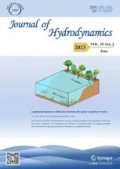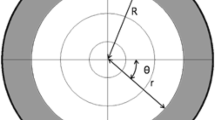Abstract
The mechanism of the flow resistance in open channels and pipelines is of vital importance for various critical issues related to the water flow. The Nikurade’s method of calculating the friction factor is not applicable in some cases. It is necessary to consider the influence of the vortex volume surrounding the vegetation and to study the hydrodynamic characteristics of the vegetated channels. This paper analyzes the variation of the vortices created by the surface roughness of different types and different sizes and proposes new definitions of the hydraulic radius and the equivalent roughness height. With consideration of the skin friction and the form drag, on the basis of the force balance equation, a novel calculation method is used for the friction factor, and this method is verified by experimental data. The hydrodynamic mechanism of the flow resistance revealed in this study may serve as a theoretical basis for hydraulic engineers to calculate the friction factor.
Similar content being viewed by others
References
Gamrat G., Favre M. R., Person L. S. et al. An experimental study and modelling of roughness effects on laminar flow in microchannels [J]. Journal of Fluid Mechanics, 2008, 594: 399–423.
Dai W. H., Ding W. Hydrodynamic improvement of a goose-head pattern braided reach in lower Yangtze River [J]. Journal of Hydrodynamics, 2019, 31(3): 614–621.
Stone B. M. Hydraulic resistance of flow in channels with cylindrical roughness [J]. Journal of Hydraulic Engineering ASCE, 2002, 128(5): 500–506.
Wu L. H., Yang X. L. Factors influencing bending rigidity of submerged vegetation [J]. Journal of Hydrodynamics, 2011, 23(6): 723–729.
Huai W. X., Zhang J., Wang W. J. et al. Turbulence structure in open channel flow with partially covered artificial emergent vegetation [J]. Journal of Hydrology, 2019, 573: 180–193.
Perry A. E., Schofield W. H., Joubert P. N. Rough wall turbulent boundary layers [J]. Journal of Fluid Mechanics, 1969, 37: 383–413.
Nikuradse J. Stromungsgesetze in glatten und rauhen rohren [M]. Berlin, Germany: VDI-Forsch, 1993.
Amiri M. M., Vitola M. A., Sphaier S. H. et al. RANS feasibility study of using roughness to mimic transition strip effect on the crossflow separation over a 6:1 prolate-spheroid [J]. Journal of Hydrodynamics, 2019, 31(3): 570–581.
Jimenez J. Turbulent flows over rough walls [J]. Annual Review of Fluid Mechanics, 2004, 36: 173–196.
Chang K., Constantinescu G., Park S. 2-D eddy resolving simulations of flow past a circular array of cylindrical plant stems [J]. Journal of Hydrodynamics, 2018, 30(2): 317–335.
Huai W., Wang W., Hu Y. Analytical model of the mean velocity distribution in an open channel with double-layered rigid vegetation [J]. Advances in Water Resources, 2014, 69: 106–113.
Huai W., Yang L., Wang W. J. Predicting the vertical low suspended sediment concentration in vegetated flow using a random displacement model [J]. Journal of Hydrology, 2019, 578: 124101.
Wen J., Hu H. B., Luo Z. Z. et al. Experimental investigation of flow past a circular cylinder with hydrophobic coating [J]. Journal of Hydrodynamics, 2018, 30(6): 992–1000.
Ligrani P. M., Moffat R. J. Structure of transitionally rough and fully rough turbulent boundary layers [J]. Journal of Fluid Mechanics, 1986, 162: 69–98.
Volino R. J., Schultz M. P., Flack K. A. Turbulence structure in a boundary layer with two-dimensional roughness [J]. Journal of Fluid Mechanics, 2009, 635: 75–101.
Roussinova V., Balachandar R. Open channel flow past a train of rib roughness [J]. Journal of Turbulence, 2011, 12: N28.
Yang S. Q., Han Y., Dharmasiri N. Flow resistance over fixed roughness elements [J]. Journal of Hydraulic Research, 2011, 49(2): 257–262.
Golly A., Turowski J. M., Badoux A. et al. Testing models of step formation against observations of channel steps in a steep mountain stream [J]. Earth Surface Processes and Landforms, 2019, 44(1): 1390–1406.
Di Stefano C., Nicosia A., Pampalone V. et al. Rill flow resistance law under equilibrium bed-load transport conditions [J]. Hydrological Processes, 2019, 33(9): 1317–1323.
Li T. S., Chen J., Han Y. et al. Study on the characteristic point location of depth average velocity in smooth open channels: Applied to channels with flat or concave boundaries [J]. Water, 2020, 12(2): 430.
Yang S. Q., Han Y., Dharmasiri N. Momentum balance method (MBM) and estimation of boundary shear stress distribution [J]. Journal of Hydraulic Engineering, ASCE, 2012, 138(7): 657–660.
Yang S. Q., Lim S. Y. Boundary shear stress distributions in trapezoidal channels [J]. Journal of Hydraulic Research, 2005, 43(1): 98–102.
Yang S. Q., Tan S. K., Lim S. Y. et al. Velocity distribution in combined wave-current flows [J]. Advances in Water Resources, 2006, 29(8): 1196–1208.
Yang S. Q., Dou G. R. Turbulent drag reduction with polymer additive in rough pipes [J]. Journal of Fluid Mechanics, 2010, 642: 279–294.
Takase K. Experimental results of heat transfer coefficients and friction factors in a 2D/3D rib-roughened annulus [J]. Experimental Thermal and Fluid Science, 1996, 13(2): 142–151.
Liu Y., Li J., Smits A. J. Roughness effects in laminar channel flow [J]. Journal of Fluid Mechanics, 2019, 876: 1129–1145.
Wagner R. N., Kandlikar S. G. Effects of structured roughness on fluid flow at the microscale level [J]. Heat Transfer Engineering, 2012, 33(6): 483–493.
Schlichting H. Experimental investigation of the problem of surface roughness [J]. Ingenieur-Archiv, 1936, 7(11): 747–748.
Knight D. W., Macdonald J. A. Hydraulic resistance of artificial strip roughness [J]. Journal of the Hydraulics Division, 1979, 105(6): 675–690.
Acknowledgements
This work was supported by the Jilin Province Key Research and Development Plan Project (Grant No. 20180201036SF), the Open Research Fund of State Key Laboratory of Information Engineering in Surveying, Mapping and Remote Sensing, Wuhan University (Grant No. 19R06), the Open Research Project of the State Key Laboratory of Industrial Control Technology, Zhejiang University (Grant No. ICT20021) and the Chinese Universities Scientific Fund (Grant Nos. 2020TC033, 10710301).
Author information
Authors and Affiliations
Corresponding author
Additional information
Projects supported by the National Natural Science Foundation of China (Grant No. 51979275).
Biography: Yu Han (1985-), Female, Ph. D., Associate Professor
Rights and permissions
About this article
Cite this article
Han, Y., Wang, Sy., Chen, J. et al. Resistance of the flow over rough surfaces. J Hydrodyn 33, 593–601 (2021). https://doi.org/10.1007/s42241-021-0039-3
Received:
Revised:
Accepted:
Published:
Issue Date:
DOI: https://doi.org/10.1007/s42241-021-0039-3



